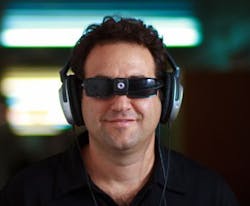Vision-based sensor helps the blind to interpret surroundings
Scientists at the Hebrew University of Jerusalem (Jerusalem, Israel) have developed a vision-based sensory substitution device (SSD) that provides visual information to the blind via their existing senses.
To use the SSD, individuals don a miniature video camera which is connected to a small computer or smart phone and stereo headphones. An algorithm then converts the images into soundscapes, allowing the user to listen to and then interpret the visual information coming from the camera.
Proficient users, who had relatively brief training in the laboratory of Dr. Amir Amedi from the Institute for Medical Research Israel-Canada at the Hebrew University, were able to use the SSD to identify complex everyday objects, locate people and their postures, and read letters and words.
More information on the research can be found here.
-- by Dave Wilson, Senior Editor, Vision Systems Design
